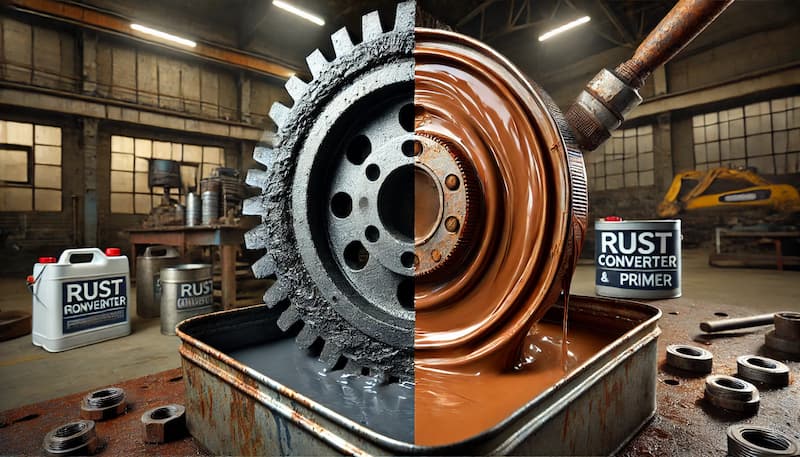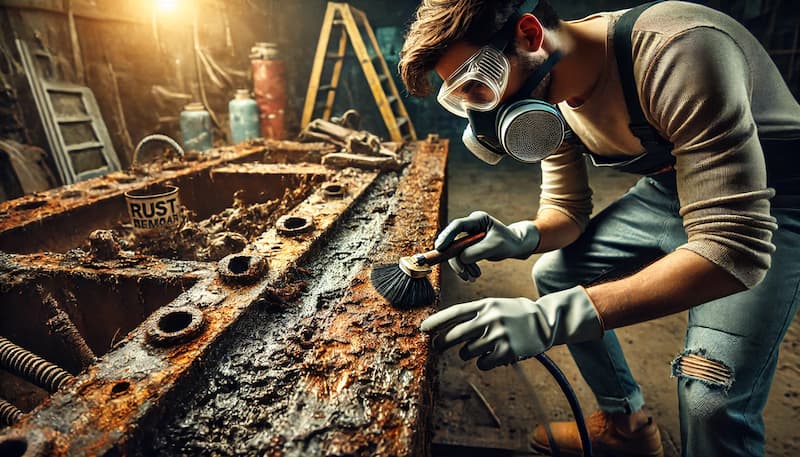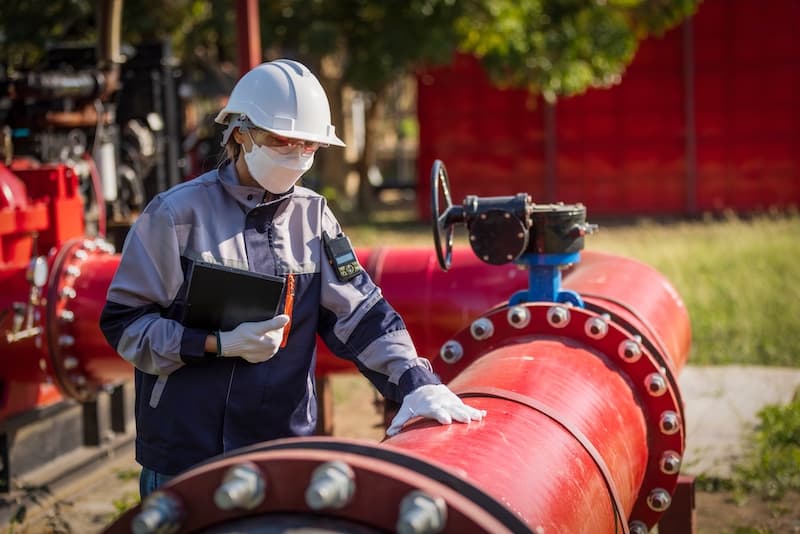No products in the cart.
The Science of Rust Converters and Primers: Effective Use of Rust Remover for Corrosion Protection
October 22, 2024
By Xion Lab
Free Shipping
easy returns
secure paymentS
FAQ | MY ACCOUNT | SUPPORT
October 22, 2024
By Xion Lab
Rust is an inevitable problem when it comes to rusty metal surfaces, especially those exposed to moisture and oxygen. The formation of rust, or iron oxide, can weaken the structure of metal objects, leading to costly repairs or even replacement. Using the rust converters and primers has become essential for effectively stopping rust and preventing further corrosion. Through chemical reactions, rust conversion agents transform the rust layer into a stable, protective layer, while a paint primer acts as a shield, preventing new rust from forming. Many polymer-based rust converters offer a durable finish, with the chemical solution creating a barrier against future rust, ensuring long-term protection of metal surfaces.
Rust is a form of iron oxide that develops when metal reacts with oxygen and moisture. The rusting process begins when iron, found in many metals, oxidizes due to exposure to air or water. Surface rust can start appearing quickly, particularly in humid environments or when metal is left unprotected. Over time, this leads to deeper corrosion, further weakening the material.
Metals such as steel, wrought iron, and sheet metal are all susceptible to rusting. Once rust begins to form, it can spread rapidly if not treated. That’s where rust converters come into play. By applying a rust converter, the rust chemically reacts and transforms into a stable compound, halting further corrosion.
The science behind rust converters lies in their ability to chemically alter rust into a stable substance. Most rust converters contain phosphoric acid or tannic acid, two active ingredients that interact with iron oxide. These acids convert the rust, forming a stable compound like iron tannate or iron phosphate, which is no longer reactive to oxygen and moisture.
Phosphoric acid reacts with rust to create iron phosphate, a black, protective layer that helps prevent further oxidation. Tannic acid, on the other hand, reacts with rust to form iron tannate, which is also stable and provides a protective barrier. In both cases, the rust is chemically altered, turning the once-corroded metal into a surface that can be safely coated with a primer.
By converting the rust into a stable layer, these chemicals ensure that the rust no longer spreads or reacts with the environment. This rust conversion process prepares the metal for the application of a primer, which acts as a further protective coating.
Primers are used after the rust conversion process to add a final layer of protection. Primers create a strong bond with the converted rust, forming a protective seal over the surface. This prevents further exposure to oxygen and moisture, significantly reducing the chances of rust reforming.
Primers come in various types, with epoxy-based and water-based primers being some of the most popular options. Epoxy primers are known for their durability and corrosion resistance, making them ideal for industrial and marine applications. Water-based primers, on the other hand, are often preferred for their eco-friendliness and ease of use. Applying a primer helps ensure that the metal surface is fully protected, even after the rust converter has stabilized the rust.
Rust converters and rust removers are often confused, but they serve different purposes. While rust converters chemically react with the rust to stabilize it, rust removers work by completely eliminating rust from the surface. Rust removers are typically used when the goal is to return the metal to its original, rust-free state.

Rust converters, on the other hand, are often used when complete rust removal is impractical or unnecessary. They allow you to treat and stabilize the rust without needing to remove it entirely. This can be particularly useful for large surfaces or when the rust has deeply penetrated the metal.
Both rust converters and rust removers play a role in corrosion protection, but their usage depends on the specific needs of the project.
Acid-based rust converters are highly effective due to their ability to remove the rust through a chemical reaction. They contain ingredients like phosphoric acid-based or tannic acid coating, which react with the rust to create a stable, non-reactive surface. This process converts rust to iron and forms a protective layer that prevents further rust formation. Acid-based rust converters are especially useful on wrought iron and steel surfaces, providing excellent corrosion resistance and rust protection. By sealing and converting the rust, these converters help prevent rust from returning.
Water based rust converters are becoming more popular for their eco-friendly approach to removing rust. These chemical solutions are designed to be less harmful to the environment, while still effectively treating rusty surfaces. Water-based converters form a conversion coating on the metal surface, which acts as a corrosion inhibitor. Although they are less aggressive than acid-based converters, they offer long-lasting protection and are suitable for rusted metal surfaces where you need to seal and prevent further damage.
Polymer-based rust converters create a strong protective layer over the converted rust, which not only treats the existing rust but also improves the adhesion of subsequent coatings like epoxy coating. These converters provide enhanced corrosion prevention by sealing the rusted surface with a durable barrier. They are particularly effective on surfaces that require a durable finish, such as steel or wrought iron. The polymer coating helps to seal and prevent rust from reappearing, offering the best results for long-term rust protection.

Before applying a rust converter, it’s essential to prepare the metal surface properly. Use a wire brush or sandpaper to remove any loose rust, paint, or debris. This ensures that the rust converter can penetrate the rust effectively and form a stable compound.
After removing loose rust, clean the surface to remove dust, oil, and other contaminants. A clean surface ensures better adhesion of the rust converter and primer, leading to a more effective rust conversion process.
Once the surface is clean, apply the rust converter evenly using a brush or spray. Make sure to cover all rusted areas thoroughly to ensure complete rust conversion. Most rust converters will darken as they react with the rust, indicating that the conversion process is taking place.
After applying the rust converter, allow sufficient time for the chemical reaction to complete. This can take anywhere from a few hours to overnight, depending on the product and environmental conditions. The rust should transform into a stable, non-reactive layer during this period.
Once the rust has been converted, it’s time to apply the primer. Primers create a strong bond with the converted rust and provide an additional layer of protection against future corrosion. Use a brush, roller, or spray to apply the primer evenly across the surface.
After the primer has dried, apply a topcoat to seal and protect the metal surface. A topcoat adds a final layer of protection, helping to prevent new rust from forming.
To ensure long-lasting corrosion protection, it’s crucial to follow a few best practices. Regularly inspect treated surfaces for any signs of rust, especially in areas exposed to harsh environmental conditions. Reapply rust converters and primers as needed, particularly if you notice any new rust forming.
Proper preparation is key to ensuring the rust converter and primer work effectively. Always clean the surface thoroughly and remove loose rust before applying any products. Applying a topcoat after priming will also help extend the life of the treated surface by creating an additional protective layer.
One of the most common mistakes people make when using rust converters is failing to prepare the surface properly. If loose rust, dirt, or oil is left on the surface, the rust converter may not adhere properly, leading to incomplete rust conversion.
Another mistake is applying too much or too little rust converter. Applying too much can result in a thick, uneven layer, while applying too little may leave areas of rust untreated. Skipping the primer or topcoat stage is also a frequent error, as it leaves the converted rust vulnerable to further corrosion.
Rust converters play a vital role in many industrial applications, particularly in sectors like automotive, construction, and marine industries. These industries often deal with large metal surfaces that are exposed to harsh conditions, making rust control a top priority.

In the automotive industry, rust converters are used to treat rusted vehicle parts, extending their lifespan and preventing costly repairs. In construction, rust converters are often applied to steel structures, ensuring that they remain structurally sound despite exposure to the elements. The marine industry relies heavily on rust converters to protect ships and other vessels from saltwater corrosion.
When selecting a rust converter, consider factors like the type of metal, the extent of the rust, and the environmental conditions the surface will be exposed to. For industrial applications, epoxy-based converters may be the best option due to their durability. Water-based converters are ideal for smaller projects or for those seeking a more eco-friendly solution.
As technology advances, new rust converters are being developed that offer improved corrosion resistance and eco-friendliness. Novel rust converters aim to provide better protection while minimizing the environmental impact. Water-based rust converters, for instance, are becoming increasingly popular due to their low toxicity and ease of cleanup.
Rust converters and primers play a crucial role in protecting metal surfaces from the damaging effects of rust. By understanding the science behind these products and applying them correctly, you can ensure long-lasting corrosion protection. Regular maintenance, proper surface preparation, and the use of high-quality primers and topcoats will help you stop rust in its tracks and extend the life of your metal surfaces.